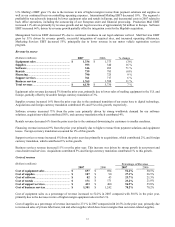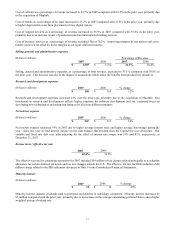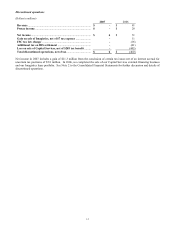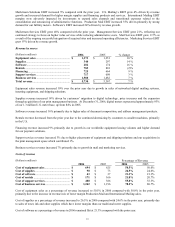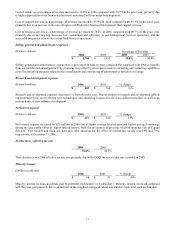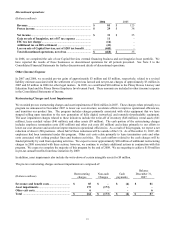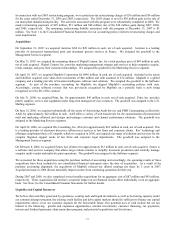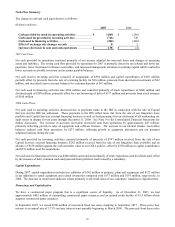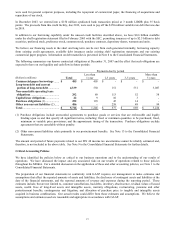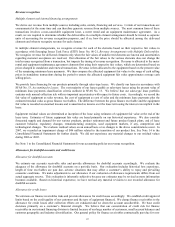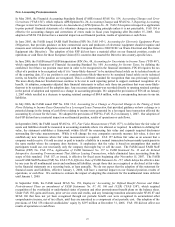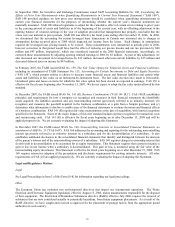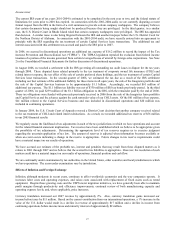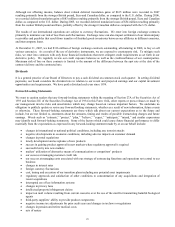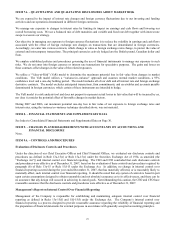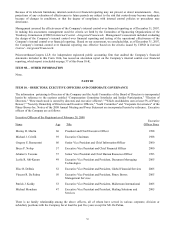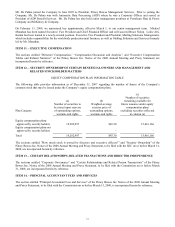Pitney Bowes 2007 Annual Report Download - page 40
Download and view the complete annual report
Please find page 40 of the 2007 Pitney Bowes annual report below. You can navigate through the pages in the report by either clicking on the pages listed below, or by using the keyword search tool below to find specific information within the annual report.22
Revenue recognition
Multiple element and internal financing arrangements
We derive our revenue from multiple sources including sales, rentals, financing and services. Certain of our transactions are
consummated at the same time and can therefore generate revenue from multiple sources. The most common form of these
transactions involves a non-cancelable equipment lease, a meter rental and an equipment maintenance agreement. As a
result, we are required to determine whether the deliverables in a multiple element arrangement should be treated as separate
units of accounting for revenue recognition purposes, and if so, how the price should be allocated among the delivered
elements and when to recognize revenue for each element.
In multiple element arrangements, we recognize revenue for each of the elements based on their respective fair values in
accordance with Emerging Issues Task Force (EITF) Issue No. 00-21, Revenue Arrangements with Multiple Deliverables.
We recognize revenue for delivered elements only when the fair values of undelivered elements are known and uncertainties
regarding customer acceptance are resolved. Our allocation of the fair values to the various elements does not change the
total revenue recognized from a transaction, but impacts the timing of revenue recognition. Revenue is allocated to the meter
rental and equipment maintenance agreement elements first using their respective fair values, which are determined based on
prices charged in standalone and renewal transactions. Revenue is then allocated to the equipment based on the present value
of the remaining minimum lease payments. We then compare the allocated equipment fair value to the range of cash selling
prices in standalone transactions during the period to ensure the allocated equipment fair value approximates average cash
selling prices.
We provide lease financing for our products primarily through sales-type leases. We classify our leases in accordance with
SFAS No. 13, Accounting for Leases. The vast majority of our leases qualify as sales-type leases using the present value of
minimum lease payments classification criteria outlined in SFAS No. 13. We believe that our sales-type lease portfolio
contains only normal collection risk with no important uncertainties with respect to future costs. Accordingly, we record the
fair value of equipment as sales revenue, the cost of equipment as cost of sales and the minimum lease payments plus the
estimated residual value as gross finance receivables. The difference between the gross finance receivable and the equipment
fair value is recorded as unearned income and is amortized as income over the lease term using the interest rate implicit in the
lease.
Equipment residual values are determined at inception of the lease using estimates of equipment fair value at the end of the
lease term. Estimates of future equipment fair value are based primarily on our historical experience. We also consider
forecasted supply and demand for our various products, product retirement and future product launch plans, end of lease
customer behavior, regulatory changes, remanufacturing strategies, used equipment markets, if any, competition and
technological changes. We evaluate residual values on an annual basis or as changes to the above considerations occur. In
2007, we recorded an impairment charge of $46 million related to the transition of our product line. See Note 14 to the
Consolidated Financial Statements for further details. We did not experience any material changes to our residual values
during 2006 or 2005.
See Note 1 to the Consolidated Financial Statements for our accounting policies on revenue recognition.
Allowances for doubtful accounts and credit losses
Allowance for doubtful accounts
We estimate our accounts receivable risks and provide allowances for doubtful accounts accordingly. We evaluate the
adequacy of the allowance for doubtful accounts on a periodic basis. Our evaluation includes historical loss experience,
length of time receivables are past due, adverse situations that may affect a customer’ s ability to repay and prevailing
economic conditions. We make adjustments to our allowance if our evaluation of allowance requirements differs from our
actual aggregate reserve. This evaluation is inherently subjective because our estimates may be revised as more information
becomes available. Based on historical experience, we have not had any material revisions to our recorded allowance for
doubtful accounts.
Allowance for credit losses
We estimate our finance receivables risks and provide allowances for credit losses accordingly. We establish credit approval
limits based on the credit quality of our customers and the type of equipment financed. We charge finance receivables to the
allowance for credit losses after collection efforts are exhausted and we deem the account uncollectible. We base credit
decisions primarily on a customer’ s financial strength. We believe that our concentration of credit risk for finance
receivables in our internal financing division is limited because of our large number of customers, small account balances and
customer geographic and industry diversification. Our general policy for finance receivables contractually past due for over


